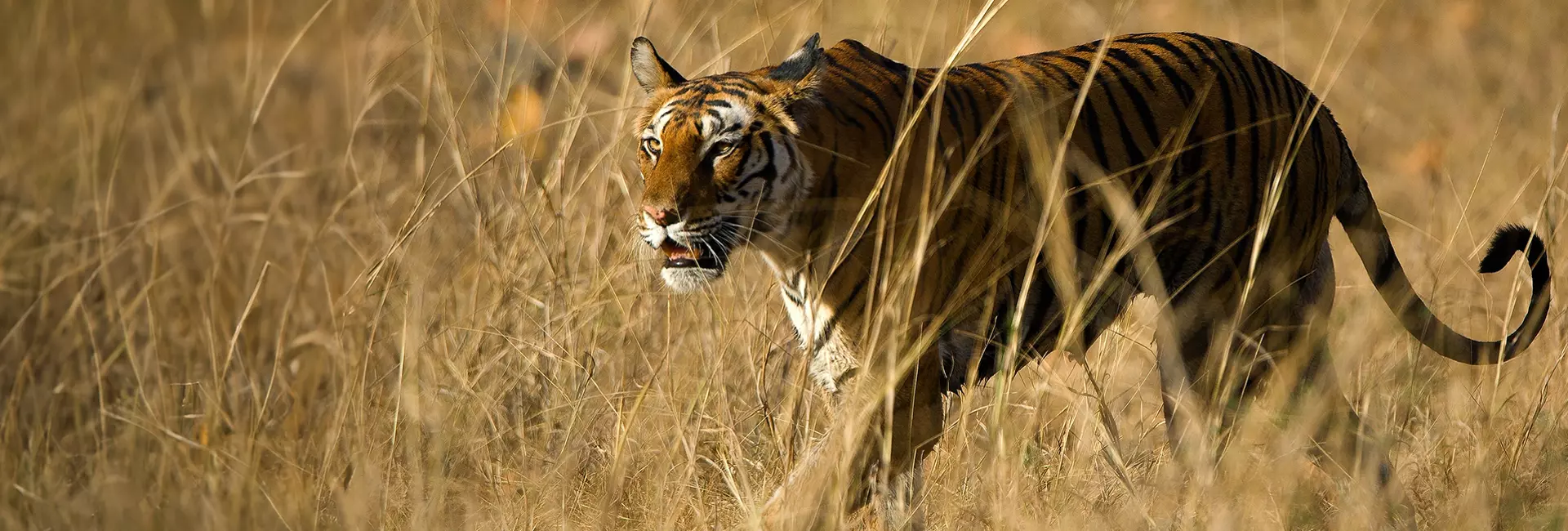
Tigers
Tiger Conservation in India
A century ago, tigers roamed across Asia with a population of around 100,000. Today, approximately 3,000 tigers remain in the wild. The relentless threats of habitat loss, human-tiger conflict, and the illegal wildlife trade, particularly the devastating tiger bone trade, have pushed these striking big cats to the brink of extinction. Despite this, tiger conservation in India has made significant strides, increasing its tiger population from 1,827 recorded in the 1972 census to 3,167 today, now safeguarding 75% of the world's remaining wild tigers. However, the revered big cat is by no means out of the woods.
By joining The Great Projects on a tiger conservation project or tour, you'll discover the beauty of world-renowned tiger reserves in India, including Ranthambore, Pench, and Kanha National Park. Whether on tiger safaris where your fee includes a conservation donation to keep tiger national parks open and thriving, educating local communities and school children on the importance of these apex predators in their ecosystems, or helping to set up camera traps used by experts to track and monitor tiger movements, your contribution lays the foundation for a future where tigers roam safely in their natural habitats - a future where exploitation is replaced by thriving tiger conservation, celebrated for years to come.
Projects Do More
12 Nights from $3,369.00
Visit the fabled Kanha National Park: home to a stunning array of wildlife, including leopards, wild dogs, and of course the famous Bengal tiger.
View projectTours See More
On the Blog
Tiger Information
Tigers At A Glance
Endangered Status
Endangered
Number remaining in the wild
Approximately 3,140
Endemic Region
Asia
According to the IUCN Red List, approximately 2,608 - 3,905 wild tigers are left in the world, with their best estimate being 3,140 mature individuals.
Tiger conservation efforts have seen tiger numbers rise, but the species is still endangered. There are several subspecies of tiger, including the South China, Malayan, and Sumatran tiger, which are classified as critically endangered due to the devastating effects of habitat loss, human-wildlife conflict and the illegal wildlife trade.
The exact number of wild tigers can vary with new surveys, conservation programs, and ongoing threats continuing to impact populations.
Shockingly, there are more tigers in captivity in the US than in the wild, with approximately 5,000 tigers kept in backyards, zoos or theme parks, and roadside attractions. Alongside this, an estimated 8,900 tigers are held captive in tiger farms in Asia, many bred solely for their bones and other body parts to be sold on the black market. Sadly, these tigers would largely be unsuitable for rewilding due to inbreeding, habituation and illness.
Tigers became endangered due to a combination of factors, which include the following:
- Habitat Loss and Fragmentation: Tigers have lost over 90% of their historical range due to deforestation, agricultural expansion, urban development, and infrastructure projects. This fragmentation isolates tiger populations, reducing their access to prey and mates, which can lead to inbreeding and reduced genetic diversity.
- Poaching & The Illegal Wildlife Trade: Tigers are hunted for their body parts, which are highly valued in traditional medicine, particularly in Asia. Poaching is the single most immediate threat to tigers, with their bones, skins, and other parts being sold on the black market, not only for traditional medicine but as trophies and symbols of power.
- The decline in Prey Populations: As human populations grow and expand into tiger habitats, the prey base that tigers rely on, such as deer, wild boar, and other large mammals, has also declined due to hunting by humans and habitat destruction. Without enough prey, tigers cannot survive or reproduce successfully.
- Human-Wildlife Conflict: As tigers lose their natural habitat and prey, they may venture closer to human settlements, leading to conflicts. Tigers sometimes prey on livestock or, in rare cases, attack humans. In retaliation, they may be killed or captured.
- Climate Change: Rising sea levels, especially in low-lying areas like the Sundarbans (a crucial habitat for Bengal tigers), threaten tiger habitats. Climate changes can also affect prey availability and lead to more frequent and severe natural disasters that further degrade tiger habitats.
As a result of these factors, the global wild tiger population has decreased dramatically over the past century. By volunteering with tigers or joining a conservation-based tiger tour, you can help mitigate these ongoing threats and be part of a conservation success story.
Key tiger conservation efforts in India have included Project Tiger, launched in 1973, which established 53 tiger reserves across the country, and stringent anti-poaching measures enforced through specialised units and technology like camera traps and drones. Habitat restoration, creation of wildlife corridors, and mitigation of human-tiger conflicts are critical components, alongside community-based eco-development programs that provide alternative livelihoods and foster conservation awareness. Scientific research, regular monitoring, and the use of advanced technologies help track tiger populations and their movements, while international collaborations and responsible ecotourism further bolster conservation efforts. These strategies have contributed to a steady increase in India's tiger population, making it home to over 75% of the global wild tiger population as of 2018.






